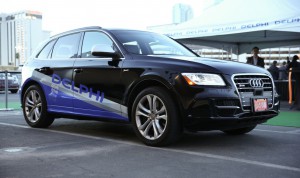
Delphi is demonstrating the capability of its automated driving system by driving an Audi Q5 from San Francisco to New York City.
Delphi, the giant automotive supplier, plans to show off the growing sophistication of its automated driving system by taking a specially equipped Audi Q5 on a 3,500-mile cross country journey starting at the Golden Gate Bridge in San Francisco and winding up in New York City.
Jeff Owens, Delphi’s chief technology officer, said the long journey will allow Delphi engineers to gather critical data and further advance the company’s active safety technology development in this rapidly growing segment of the auto industry. The car will also have an engineer/observer in the driver’s seat but they won’t operate the car.
“Delphi had great success testing its car in California and on the streets of Las Vegas,” Owens said. “Now it’s time to put our vehicle to the ultimate test by broadening the range of driving conditions. This drive will help us collect invaluable data in our quest to deliver the best automotive grade technologies on the market.”
Other automakers, such as Audi and Mercedes-Benz have also staged demonstration drives of autonomous vehicles. The Mercedes-Benz drive in 2013 duplicated the famous 64-mile road trip in 1888 by Bertha Benz. Google also has accumulated thousands of miles of driving for its test cars.
The coast-to-coast road trip — believed to be the longest U.S. journey yet for an autonomous car — is now the next step in developing the technology.
During Delphi’s cross-country trip, the vehicle will face variety of driving conditions from changing weather and terrain to potential road hazards – things that could never truly be tested in a lab, Owens said.
“Delphi had great success testing its car in California and on the streets of Las Vegas,” Owens said. “Now it’s time to put our vehicle to the ultimate test by broadening the range of driving conditions. This drive will help us collect invaluable data in our quest to deliver the best automotive grade technologies on the market.”
The Q5 will be outfitted out with laser sensors, radar and multiple cameras, and the journey is expected to take about a week to complete. Delphi has already tested the vehicle California and the company previously showed off its work at CES earlier this year.
Delphi’s team say that driving for several hours a day in varying weather conditions will give it a valuable new bank of data to work with. The Audi A5 being used can already merge onto highways, navigate through four-way junctions, and give room to cyclists, though right now the advanced equipment required puts it out of the price range of the average motorist.
(Makers scramble to bolster in-car cyber security. For more, Click Here.)
Delphi’s active safety technologies enable the vehicle to instantaneously make complex decisions, like stopping and then proceeding at a four-way stop, timing a highway merge or calculating the safest maneuver around a bicyclist on a city street. Many of these driving scenarios have been a limitation for much of the current technology on the market today.
“Our comprehensive product portfolio and vehicle integration expertise uniquely positions Delphi as one of only a handful of companies with the ability to provide automakers complete automated driving solutions,” said Owens.
(Click Here for details about Audi’s autonomous race car.)
Delphi’s automated driving vehicle leverages a full suite of technologies to make this trip, including radar, vision and advanced drive assistance systems multi-domain controller. It also has a high-end microprocessor to drive multiple features and functions such897ipol; as wireless vehicle-to-vehicle communication technology, which extends the range of existing ADAS functionality
Intelligent software enables the vehicle to make complex, human-like decisions for real-world automated driving during traffic jams as well as on the highway with lane change and on-ramp to off-ramp piloting and automated parking.
For Delphi, which up until 1999 was part of General Motors, the journey is also a major milestone.
(To see more about Henrik Fisker’s Thunderbolt GT Coupe concept, Click Here.)
Delphi filed for bankruptcy in 2005 and wasn’t able to assemble an exit plant until 2009 when the company was re-organized to emphasize electronics and other technical assets. Since then the company has been able to re-invest in technology and has taken a lead in protecting cars from hackers as well as in advance safety system and driver assistance.
Coast-to-coast drives have a special place in automotive history, having been used to demonstrate the reliability of automobiles in the industry’s early days.

As long as the driver can override the electronics if needed, this is an acceptable test. It’s more than likely that some glitches will develop. In addition the ethical issues have yet to be resolved amongst autonomous auto builders, government, lawyers and citizens.